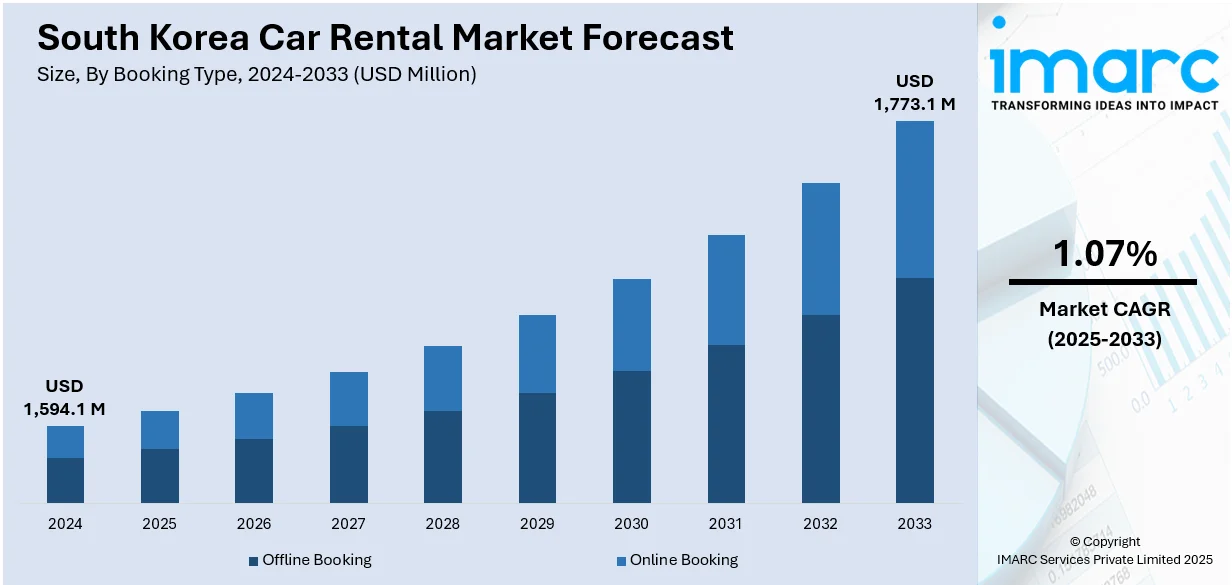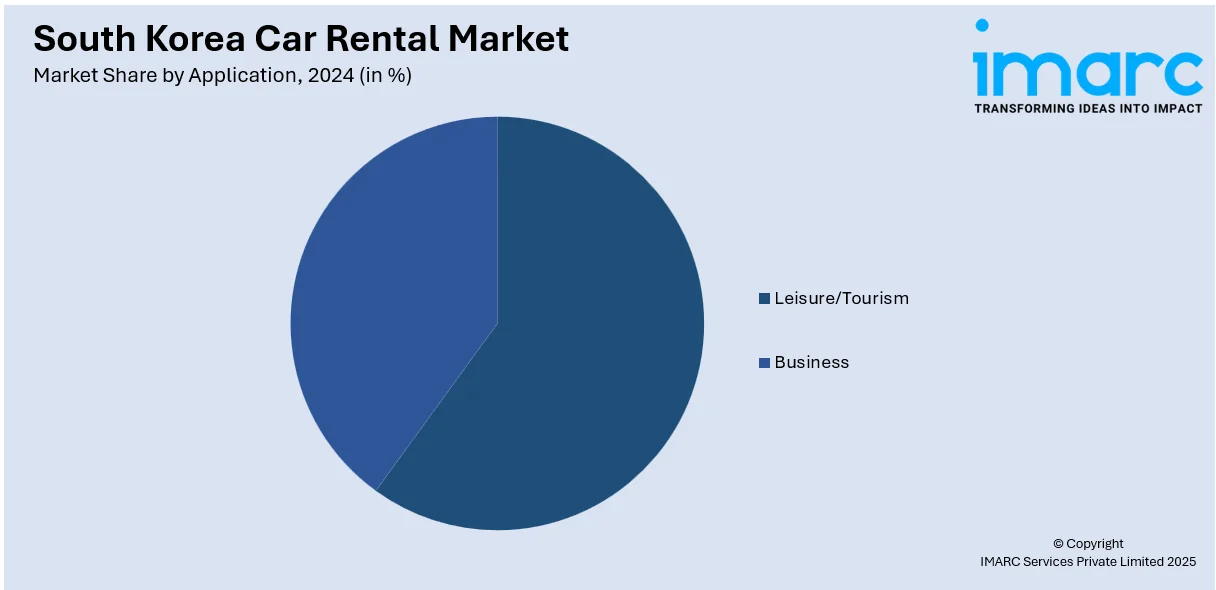
South Korea Car Rental Market Size, Share, Trends and Forecast by Booking Type, Rental Length, Vehicle Type, Application, End User, and Region, 2025-2033
South Korea Car Rental Market Overview:
The South Korea car rental market size reached USD 1,594.1 Million in 2024. The market is projected to reach USD 1,773.1 Million by 2033, exhibiting a growth rate (CAGR) of 1.07% during 2025-2033. The market is experiencing significant growth driven by increasing demand for flexible rental terms and eco-friendly vehicle options. Technological advancements and government support for electric vehicles are further propelling this trend, contributing to the rising South Korea car rental market share across various consumer segments.
|
Report Attribute
|
Key Statistics
|
|---|---|
|
Base Year
|
2024 |
|
Forecast Years
|
2025-2033
|
|
Historical Years
|
2019-2024
|
| Market Size in 2024 | USD 1,594.1 Million |
| Market Forecast in 2033 | USD 1,773.1 Million |
| Market Growth Rate 2025-2033 | 1.07% |
South Korea Car Rental Market Trends:
Growing Preference for Flexible Rental Terms
The South Korean automobile rental market is undergoing a drastic shift towards flexibility in rental conditions, following changing consumer behavior and expectations. Consumers are prioritizing convenience, which has been driving demand for services that offer flexibility in rental period, vehicle, and pick-up or drop-off location. This rising demand for flexibility has been particularly common among home and abroad visitors who desire freedom from the obligation of full-car ownership. As a result, short-term rental, hourly reservation, and one-way rental are gaining momentum. In addition, applying technology to become part of the rental process has been a dominant reason for this shift. Internet-based websites and mobile apps facilitate customers in booking cars, managing bookings, and even choosing some add-ons like car types or rental offers. This technology-driven process makes the customer experience smoother and more tailored. With consumers demanding even greater convenience and customized options, South Korean car rental firms are expanding their service list by adding more flexible rental programs, thus contributing to the South Korea car rental market growth.

To get more information on this market, Request Sample
Increased Adoption of Electric Vehicles
South Korea's automobile rental industry has experienced a significant increase in the use of electric vehicles (EVs) to meet increasing environmental awareness and government incentives. Moreover, customers are looking for environmentally friendly options compared to conventional gasoline-run cars, and car rental firms are responding by adding more electric and hybrid models to their fleets. This trend is most dominant among eco-friendly consumers, most notably younger generations of people who place great importance on sustainability in traveling. The presence of EVs in the rental industry is also being strengthened by efforts from the South Korean government to encourage green transportation through the offering of subsidies and tax credits for the purchase of electric vehicles. Another reason for the rising demand for electric vehicles in the rental market is the growth in EV charging infrastructure. With more charging points spread out in key urban centres, the ease of renting electric vehicles for short periods increases, further pushing the demand. This trend towards eco-friendly cars follows international directions within the automobile sector and will continue to expand in South Korea, as car rental companies target servicing the demand for green modes of transport. This movement is a key development in creating an environmentally friendly car rental business in South Korea.
South Korea Car Rental Market Segmentation:
IMARC Group provides an analysis of the key trends in each segment of the market, along with forecasts at the country and regional level for 2025-2033. Our report has categorized the market based on booking type, rental length, vehicle type, application, and end user.
Booking Type Insights:
- Offline Booking
- Online Booking
The report has provided a detailed breakup and analysis of the market based on the booking type. This includes offline booking and online booking.
Rental Length Insights:
- Short Term
- Long Term
A detailed breakup and analysis of the market based on the rental length have also been provided in the report. This includes short term and long term.
Vehicle Type Insights:
- Luxury
- Executive
- Economy
- SUVs
- Others
The report has provided a detailed breakup and analysis of the market based on the vehicle type. This includes luxury, executive, economy, SUVs, and others.
Application Insights:

- Leisure/Tourism
- Business
A detailed breakup and analysis of the market based on the application have also been provided in the report. This includes leisure/tourism and business.
End User Insights:
- Self-Driven
- Chauffeur-Driven
The report has provided a detailed breakup and analysis of the market based on the end user. This includes self-driven and chauffeur-driven.
Regional Insights:
- Seoul Capital Area
- Yeongnam (Southeastern Region)
- Honam (Southwestern Region)
- Hoseo (Central Region)
- Others
The report has also provided a comprehensive analysis of all the major regional markets, which include Seoul Capital Area, Yeongnam (Southeastern Region), Honam (Southwestern Region), Hoseo (Central Region), and others.
Competitive Landscape:
The market research report has also provided a comprehensive analysis of the competitive landscape. Competitive analysis such as market structure, key player positioning, top winning strategies, competitive dashboard, and company evaluation quadrant has been covered in the report. Also, detailed profiles of all major companies have been provided.
South Korea Car Rental Market News:
- July 2025: SK Rent-a-Car launched Korea’s first one-stop Auto Auction platform, aiming to sell 100,000 verified used cars annually. This move enhanced transparency with a unique vehicle verification process, impacting the car rental market by increasing market share and fostering consumer trust in used car services.
South Korea Car Rental Market Report Coverage:
| Report Features | Details |
|---|---|
| Base Year of the Analysis | 2024 |
| Historical Period | 2019-2024 |
| Forecast Period | 2025-2033 |
| Units | Million USD |
| Scope of the Report |
Exploration of Historical Trends and Market Outlook, Industry Catalysts and Challenges, Segment-Wise Historical and Future Market Assessment:
|
| Booking Types Covered | Offline Booking, Online Booking |
| Rental Lengths Covered | Short Term, Long Term |
| Vehicle Types Covered | Luxury, Executive, Economy, SUVs, Others |
| Applications Covered | Leisure/Tourism, Business |
| End Users Covered | Self-Driven, Chauffeur-Driven |
| Regions Covered | Seoul Capital Area, Yeongnam (Southeastern Region), Honam (Southwestern Region), Hoseo (Central Region), Others |
| Customization Scope | 10% Free Customization |
| Post-Sale Analyst Support | 10-12 Weeks |
| Delivery Format | PDF and Excel through Email (We can also provide the editable version of the report in PPT/Word format on special request) |
Key Questions Answered in This Report:
- How has the South Korea car rental market performed so far and how will it perform in the coming years?
- What is the breakup of the South Korea car rental market on the basis of booking type?
- What is the breakup of the South Korea car rental market on the basis of rental length?
- What is the breakup of the South Korea car rental market on the basis of vehicle type?
- What is the breakup of the South Korea car rental market on the basis of application?
- What is the breakup of the South Korea car rental market on the basis of end user?
- What is the breakup of the South Korea car rental market on the basis of region?
- What are the various stages in the value chain of the South Korea car rental market?
- What are the key driving factors and challenges in the South Korea car rental market?
- What is the structure of the South Korea car rental market and who are the key players?
- What is the degree of competition in the South Korea car rental market?
Key Benefits for Stakeholders:
- IMARC’s industry report offers a comprehensive quantitative analysis of various market segments, historical and current market trends, market forecasts, and dynamics of the South Korea car rental market from 2019-2033.
- The research report provides the latest information on the market drivers, challenges, and opportunities in the South Korea car rental market.
- Porter's Five Forces analysis assists stakeholders in assessing the impact of new entrants, competitive rivalry, supplier power, buyer power, and the threat of substitution. It helps stakeholders to analyze the level of competition within the South Korea car rental industry and its attractiveness.
- Competitive landscape allows stakeholders to understand their competitive booking type and provides an insight into the current positions of key players in the market.
Need more help?
- Speak to our experienced analysts for insights on the current market scenarios.
- Include additional segments and countries to customize the report as per your requirement.
- Gain an unparalleled competitive advantage in your domain by understanding how to utilize the report and positively impacting your operations and revenue.
- For further assistance, please connect with our analysts.
 Request Customization
Request Customization
 Speak to an Analyst
Speak to an Analyst
 Request Brochure
Request Brochure
 Inquire Before Buying
Inquire Before Buying




.webp)




.webp)












